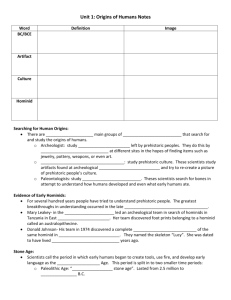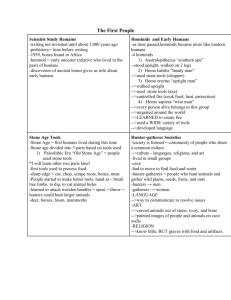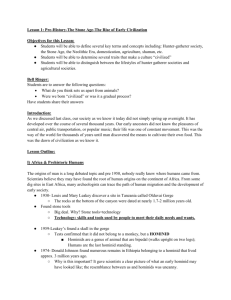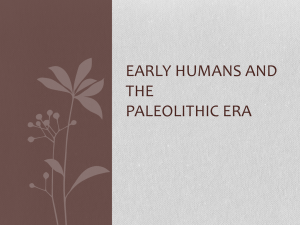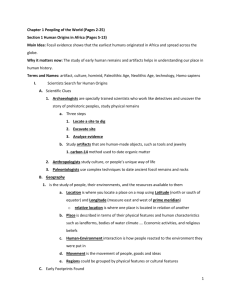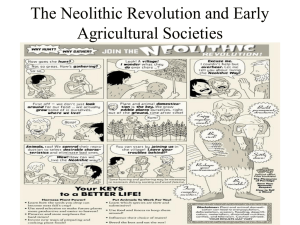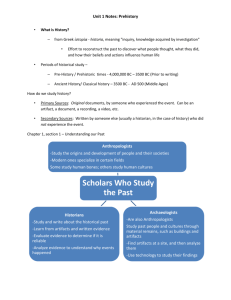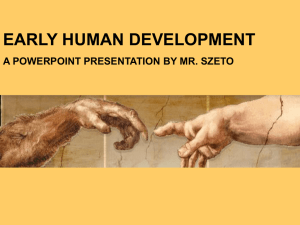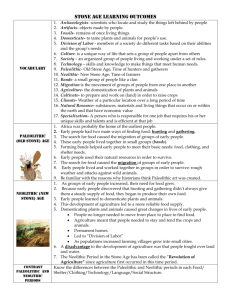The Neolithic Revolution
advertisement
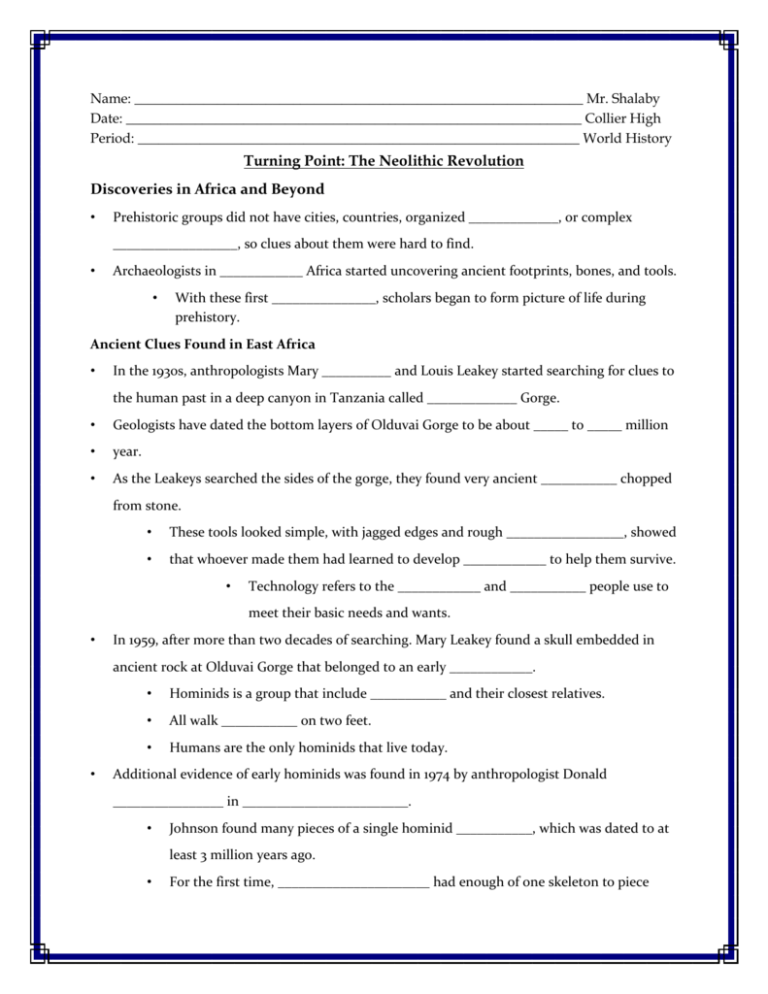
Name: _________________________________________________________________ Mr. Shalaby Date: __________________________________________________________________ Collier High Period: ________________________________________________________________ World History Turning Point: The Neolithic Revolution Discoveries in Africa and Beyond • Prehistoric groups did not have cities, countries, organized _____________, or complex __________________, so clues about them were hard to find. • Archaeologists in ____________ Africa started uncovering ancient footprints, bones, and tools. • With these first _______________, scholars began to form picture of life during prehistory. Ancient Clues Found in East Africa • In the 1930s, anthropologists Mary __________ and Louis Leakey started searching for clues to the human past in a deep canyon in Tanzania called _____________ Gorge. • Geologists have dated the bottom layers of Olduvai Gorge to be about _____ to _____ million • year. • As the Leakeys searched the sides of the gorge, they found very ancient ___________ chopped from stone. • These tools looked simple, with jagged edges and rough _________________, showed • that whoever made them had learned to develop ____________ to help them survive. • Technology refers to the ____________ and ___________ people use to meet their basic needs and wants. • In 1959, after more than two decades of searching. Mary Leakey found a skull embedded in ancient rock at Olduvai Gorge that belonged to an early ____________. • • Hominids is a group that include ___________ and their closest relatives. • All walk ___________ on two feet. • Humans are the only hominids that live today. Additional evidence of early hominids was found in 1974 by anthropologist Donald ________________ in ________________________. • Johnson found many pieces of a single hominid ___________, which was dated to at least 3 million years ago. • For the first time, ______________________ had enough of one skeleton to piece together and really look at an early hominid. • • Johnson named his historic find “_____________” after a Beatles’ song. Studying Lucy’s skeleton, Johnson could see that she was an_____________ walker who was about 4 feet (1.2 meters) tall. Evidence of Early Hominid Groups • Anthropologists _____________ and studied numerous remains and artifacts of hominids. • From this work, they have established that a number of ___________ groups of hominids lived over the course of several million years. First Finds of Humans Around the World • Scientists think that between 250,000 and 100,000 years ago, Homo erectus _____________ and a new group of hominids emerged – Called Homo _______________, the group which ___________ humans belong. • • Two groups of Homo Sapiens arose • ___________________ • Earliest Modern humans Early modern humans eventually spread all over the world, while Neanderthals lived mostly in ______________ and _____________________ sometime between 50,000 and 30,000 years ago. The Neolithic Revolution • Anthropologists divided _______________ into different eras. • The period between 2 million B.C. to about 10,000 B.C. is called the ______ Stone Age, or ____________ Period. • The period between 10,000 B.C. until the end of prehistory is called the _______ Stone Age, or ____________ Period. • During both eras, people created and used various types of __________ tools. However, during the New Stone Age, people began to develop new _________ and technologies that led to dramatic changes in their everyday lives. Skills and Beliefs of the Old Stone Age • Early modern humans were _____________ – people who move from one place to another to find food. • About 20 or 30 people lived together in small ___________, or groups. • They were _____________ gatherers. • Men _________ and/or fished. • Women and children ___________ berries, fruits, nuts, grains, roots or shellfish. Humans Developed Strategies for Survival • Early people depended heavily on their _____________ for food and shelter. • They also found ways to ____________ their surroundings to their needs. • Early humans made tools and _____________ out of the materials at hand – Stone, bone or wood. • • They built _________ for cooking and used animal skins for ___________. Early modern humans developed spoken _____________, which allowed them to _______________ during the hunt and perhaps discuss plans for the future. Humans Developed Strategies for Survival • Some Old Stone Age people also learned to _____________ across water. • People boated from Southeast Asia to _______________ at least 40,000 years ago most likely using __________ or _____________. • They may have stopped for years at ____________ along the way. Early Religious Beliefs • Toward the end of the Old Stone Age, people began to leave ___________ of their belief in a _____________ world. • About 100,000 years ago, some people began ____________ their dead with great care. • • They may suggest in the belief of life after ___________. Old Stone Age people may have believed the ____________ would be similar to life in this world and thus provided the dead with ____________, weapons, and other needed goods to take with them. • Our ____________ believed the world was full of __________ and forces that might reside in animals, objects, or dreams. • Such beliefs are known as ____________. The New Stone Age Begins with Farming • By _________________ their own food, people no longer need to roam in search of food. • As a result, early ___________ settled the first __________ village and developed new skills and technologies. • This transition from nomadic life to settled farming is called _____________ Revolution. People Domesticate Plants and Animals • These early farmers were the first humans to ___________ plants and animals. • • To raise them in a ___________ way that makes them best suited to human use. The ________ was probably the first animal to be domesticated, at least 15,000 years ago. Neolithic Revolution Brings Dramatic Change • The advances of the Neolithic Revolution led to a new stage of development – the emergence of cities and ____________________.
